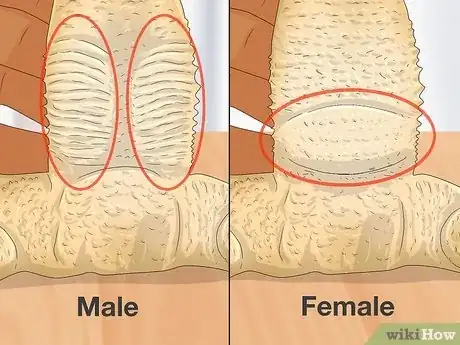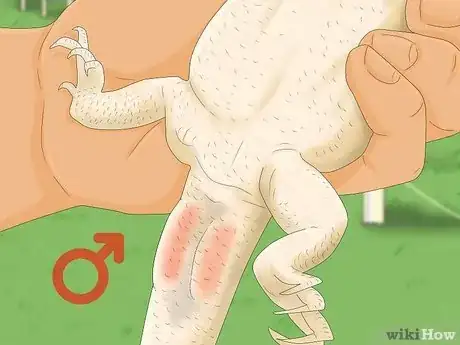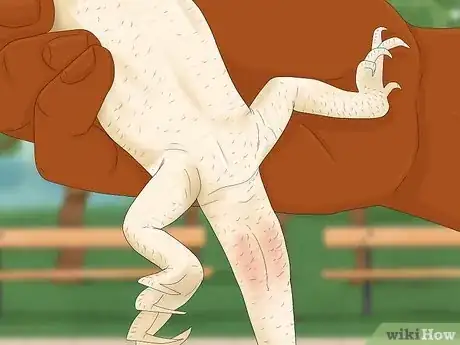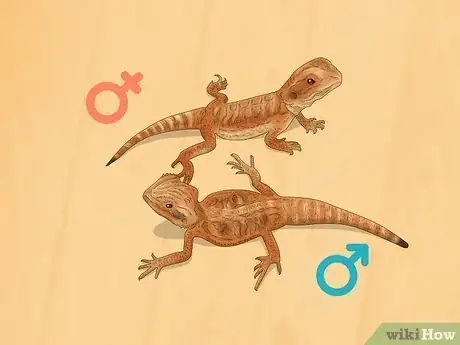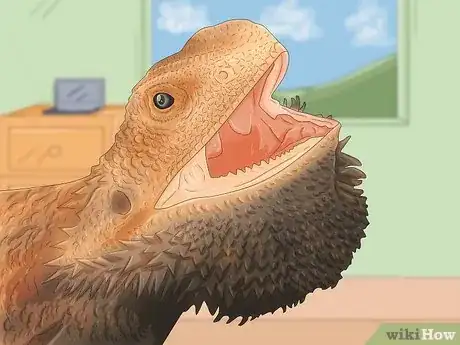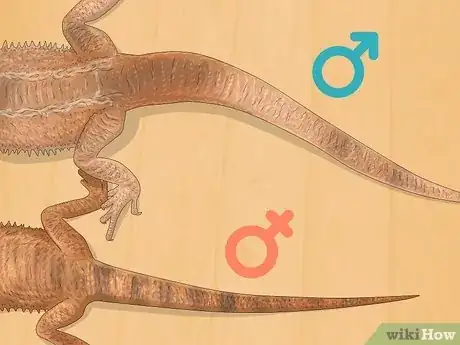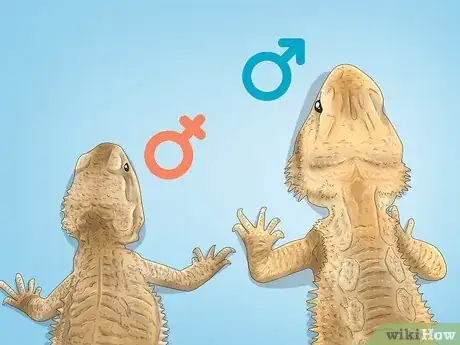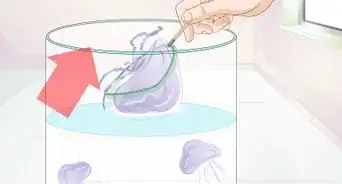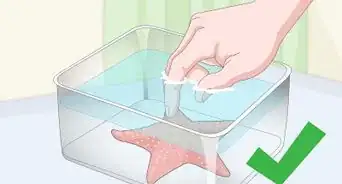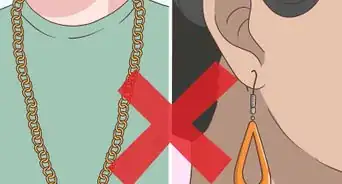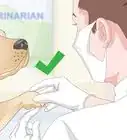This article was co-authored by Alisa Rassin. Alias Rassin is an Exotics Veterinarian and the Owner of The Exotic Animal Hospital of Pennsylvania in Lansdowne, Pennsylvania. With over a decade of experience, she specializes in treating reptiles, birds, and small mammals. She holds a Veterinariae Medicinae Doctoris from The University of Pennsylvania and a BS in Veterinary Biomedical and Clinical Sciences from Penn State University. She was also certified by the Royal College of Veterinary Surgeons.
There are 9 references cited in this article, which can be found at the bottom of the page.
This article has been viewed 5,312 times.
Whether you’re trying to name your pet beardie or you’re just curious about their gender, you're in luck: there are multiple reliable methods for sexing your bearded dragon from home. Male and female bearded dragons look very similar, but they have distinct features and behavior that set them apart. It may be tricky for new parents to sex their beardie, but luckily, we’ve provided everything you need to know! Here’s an in-depth guide on how to sex your bearded dragon (or baby beardie) so you can build a loving relationship with them. It’s important to note that babies are more difficult to sex, so wait 8 to 12 weeks before sexing your beardie for the most accurate results.
Things You Should Know
- To sex your bearded dragon, run your fingers on the underside of the tail base to check for hemipenal bulges (sex organs). Male beardies have 2 bulges, while females only have one.
- Search the underside of your beardie’s back legs for large spots (femoral pores). Unlike females, male beardies have pronounced pores scattered across their back thighs.
- Male bearded dragons are larger than females and typically show more aggressive behavior.
Steps
Sexing Your Bearded Dragon
-
1Feel for hemipenal bulges. Place your beardie on a flat surface and softly lift their tail 90 degrees. Gently run your fingers along the underside of the tail base to feel for small hemipenal bulges (sex organs). There are two defined vertical grooves on each side of the tail base for males.[1]
- Female beardies have a single bulge in the center of their tail (in the same location as the male).
- Make sure to handle your bearded dragon with care: never grab the tip of the tail–it can break and hurt your beardie.
-
2Look for the presence of hemipenes. In a dark room, place your beardie flat in your palm and use your other hand to shine a flashlight above the top of their tail. With the light shining through the tail, maneuver your thumb to gently lift your beardie’s tail and check the underside for hemipenes. Males have two red vertical bulges with dark shadows surrounding them.[2]
- Female bearded dragons have one v-shaped mound in the center of their tail.
- If the bulges are hard to see, gently turn your bearded dragon at different angles to look for any shadowing.
Advertisement -
3Check the size of the femoral pores. Femoral pores are small spot-like glands that excrete pheromones, which beardies use to mate and mark territory. While both males and females have them, femoral pores on females are not visible. Male bearded dragons have pronounced femoral pores that look like small circles on the back of their legs.
- In the palm of your hand, gently support the back of your beardie so they are belly-side up. If there are several circles scattered across the back thighs, you have a male beardie.[3]
- Femoral pores fully develop when your beardie reaches adulthood (12 months), so avoid using this method for baby beardies.[4]
- If you're unsure of the size of your beardie's femoral pores, compare your beardie with an online photo of a male bearded dragon's femoral pores.
-
4If you have two beardies, compare the sizes of their cloacal openings. The cloaca is a chamber at the rear end of reptiles that connects the urinary, reproductive, and digestive tracts.[5] On bearded dragons, the cloaca empties through a small vent-like opening that looks like a slit between the back legs (on the underside of the tail), and males have a wider cloacal opening than females.[6]
- If you don’t have two bearded dragons, compare your beardie with a photo of the cloacal opening online.
How to Sex a Baby Beardie
-
1Check the underside of the tail for hemipenes. Hold your bearded dragon with their belly flat on your palm, and use your other hand to shine a flashlight on the top of the tail base. With your thumb, gently lift your beardie’s tail, and look for hemipenal bulges (on the underside of the tail). Male beardies have 2 red bulges with dark shadows, while females only have one bulge in the center.[7]
-
2Observe the tail length. Even as babies, female bearded dragons typically have smaller, narrow tails compared to males. Male beardies have thicker tails, especially toward the base.[8]
Male vs Female Differences
-
1Usually, male bearded dragons are aggressive, while females are submissive. Male beardies hiss, stomp, or bob their head fiercely as a sign of territorial aggression. They’re also known to fluff their beards to appear bigger and more threatening.[9]
- When encountering males, female beardies often adopt a submissive pose by waving their arms in a circle, but some females aren’t afraid to engage in more aggressive behavior.[10]
- Both males and females have black beards (throat pouches), but male beardies are more likely to darken their beard during courtship to show dominance.[11]
- Beardies act aggressively in response to stress but get veterinary care if you notice your pet is behaving abnormally.
-
2Male beardies have large tails, while female beardies have smaller ones. In the wild, males typically have longer and wider tails than females. But, there are too many environmental factors–diet, cage environment–that can alter their tail’s size.[12]
- Female beardies are known to have a more narrow and slender tail than males.
- Bearded dragons can grow up to 24 inches, with their tail taking up half their length.[13]
-
3Males have wide, thick heads, while females have long, narrow heads. Bearded dragons have triangular-shaped heads, but females have thinner skulls and smaller beards than males.[14]
Things You’ll Need
- Flashlight
References
- ↑ https://youtu.be/TrvTS46kuL8?t=84
- ↑ https://youtu.be/TrvTS46kuL8?t=84
- ↑ https://youtu.be/6wyA1UYsqEA?t=363
- ↑ https://youtu.be/gcOiMR5OX-k?t=42
- ↑ https://www.petmd.com/reptile/conditions/reproductive/c_rp_infectious_cloacitis
- ↑ https://reptilia.org/bearded-dragon
- ↑ https://youtu.be/TrvTS46kuL8?t=83
- ↑ https://espace.library.uq.edu.au/data/UQ_229678/BeardedDragon.pdf
- ↑ https://espace.library.uq.edu.au/data/UQ_229678/BeardedDragon.pdf
